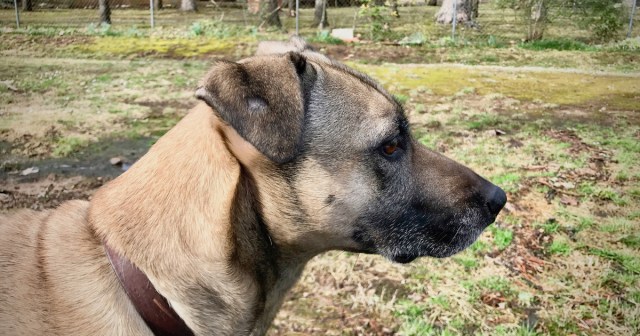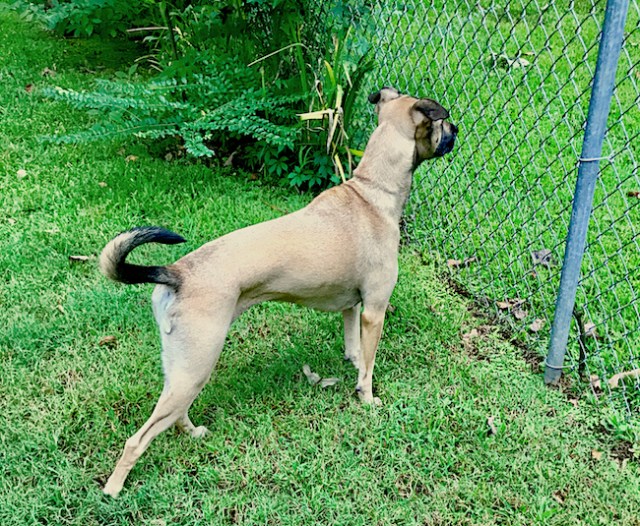Barks Blog
Teaching Your Dog to Self-Interrupt
By Eileen Anderson

Here is something I taught with positive reinforcement that enhances Clara’s life and mine. I’ve taught her to respond positively to being interrupted, and even to interrupt herself. This trained behavior helps us get along smoothly from day to day, and also helps keep her safe in the world.
Self-interruption is related to a whole batch of desirable dog behaviors. I mean desirable to us humans, but they are beneficial to the dogs, too. People refer variously to reorientation, offered attention, checking in, and more. Even recall is related. By whatever name, these are safety behaviors. When you can get your dog’s attention easily, and when they offer attention on their own, you can get them out of many emergencies without a fuss.
What Does Self-Interruption Look Like?
Over the years, I have taught Clara to interrupt her own behavior when there is something intense going on in the environment. She stops and checks in with me. If she’s next to me already, she turns and looks at me. If she’s across the yard or in another part of the house, she runs to me. This ability to turn away from something that’s bothering her has the effect of lowering her arousal. Self-interruption also means it’s easy to get her out of sticky situations. She does most of the work herself!
Clara was a feral puppy and came to me with suspicions of humans preinstalled. She is 8 years old now. She now has some other people besides me in her trusted circle, and can happily walk on-leash in densely populated areas. She’s good with bicycles, baby carriages, wheelchairs, and all kinds of assistive equipment. All kinds of people in all sorts of attire. She would rather not be approached, but if people have moderately polite body language, she can tolerate it. I generally arrange things so she doesn’t have to interact.
At home, she keeps an eye on the neighbors, city and construction workers, the neighborhood dogs, and other animals. But instead of fence-running, endlessly alarm barking, or evading me, she generally takes a look, expresses her opinion with a huff or two, then checks in with me.
You can see it in this unedited video. Instead of being glued to the fence and barking at the neighbors, she watches, checks in with me twice on her own, and turns on a dime when I call her. She also responds instantly when I suggest we go inside.
The video is badly recorded—sorry!
This is normal everyday behavior for her. She has learned to interrupt her own fixation on things that bother her. This was all taught with classical conditioning and positive reinforcement.
Training Self-Interruption
Clara was well prepared to learn self-interruption because I classically conditioned her as a puppy that another dog barking made wonderful food happen. I didn’t want her to “catch” my reactive dog’s habits. It worked. Classically conditioning a dog to any stimulus and then providing the goodie yourself is going to have the effect, over time, of them reorienting to you when the stimulus occurs. This gave Clara and me a jump start on interruption training.

The first thing is to interrupt the dog a lot and pay super well for it. At first, only interrupt when you think their attention is wavering away from whatever has their focus. For example, when they are turning toward you anyway. If they are playing, perhaps they have taken a break and are looking around. Call them, then reinforce like crazy when they come. Gradually, you can start to call them in more difficult situations. And sometimes you can do like I did in the video and encourage the dog to go return to what she was doing. (I don’t usually encourage her to go back when she is worried about something she sees, but this time she seemed to want one more look and I thought it would work out all right.)
What I have described is part of many recall training plans. But if you do it enough and the dog will probably start to offer the behavior without a deliberate cue from you. Treat like crazy! Then build up the habit with reinforcement.
In the video, I had kibble in my hand. But Clara’s habit was built with things like roast chicken, spray cheese, and cat food in a tube!
A second thing to do is to teach the dog that treats fall from heaven whenever anything weird happens in the environment. Does a jogger appear out of nowhere? Treat! Someone drops a garbage can lid next door? Treat!
Did you notice in my video that the first time Clara runs to me is after there is a loud noise? She knows noises make treats happen. So instead of getting upset, trying to locate the noise, and barking in that general direction (which I guarantee is what she would have done without training), she runs to me.
Most of the things that get her attention in the yard worry her a bit. It may be interesting to watch the neighbors and what goes on in the street, but it’s not usually fun. Trained self-interruption gives her a way to get “unstuck.” If there’s too much going on, we go into the house, and she is glad to do so.
Because of positive reinforcement training, I never have to fight to get Clara’s attention. I don’t have to yell or nag. This dog who arrived with so many strikes against her is a dream to live with. Besides making life more pleasant, her responsiveness makes it safer for her to go out and about in the world. I can always “reach” her, and her recall is practically reflexive.
Related Posts
- Classical Conditioning: Creating a Positive Response To Barking
- The Barking Recall
- Actually, I **Can** Get My Dogs’ Attention
- Socializing a Formerly Feral Dog
Copyright 2019 Eileen Anderson
About the Author
Passionate amateur dog trainer, writer, and learning theory geek. See more at https://eileenanddogs.com.
